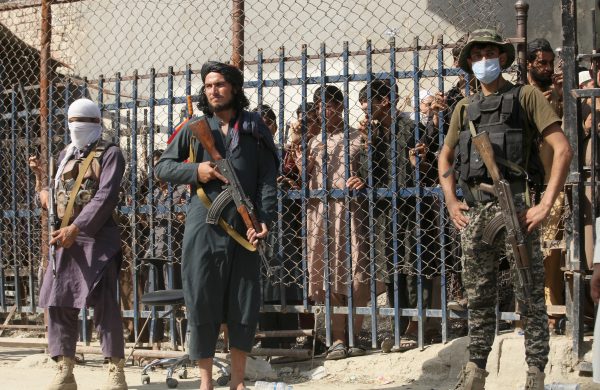
Pakistani Taliban to Benefit from Afghanistan-Pakistan Border Fencing Dispute
Publication: Terrorism Monitor Volume: 20 Issue: 1
By:

On December 18, 2021, Afghan Taliban soldiers disrupted the erection of a security fence by the Pakistani military along the two countries’ mutual border and seized spools of barbed wire (Express Tribune, January 3). Defending his government’s move to disrupt the fencing work, the Afghan Defense Ministry spokesman, Enayatullah Khwarazm, declared the fencing of the border by Pakistan “illegal” (Dawn, December 23, 2021). In the past four years around 94 percent of the fencing of the border has been completed, and the Pakistani army is fully determined to complete the rest of the fencing work. In a press statement, Director General of Inter-Services Public Relations (ISPR), Major General Babar Iftikhar, stated, “The blood of our martyrs was spilled in erecting this fence. It is a fence of peace and will be completed and remain [in place]” (Dawn, January 5).
The conflict stems from disagreements over the legitimacy of the Durand Line, which is a boundary demarcation created when Afghanistan’s King Abdul Rahman Kahn and British India’s Foreign Secretary Sir Mortimer Durand signed an agreement in 1893. Since then, the 2,600-kilometer border has largely been a lawless, porous, mountainous border with largely unfrequented routes. However, the border is not without controversy. Like the previous Afghan government led by President Ashraf Ghani, the Afghan Taliban have also been against the fencing of the border along the Durand Line.
If the fencing issue is not resolved diplomatically between Pakistan and the Afghan Taliban government, then escalating tensions on border could eventually lead to a clash between the two sides.
Border Fencing and Souring Pakistan-Afghanistan Relations
While the Afghan government sees the Durand Line as divisive because it splits the families and tribes on either side of the border, Pakistan considers it an internationally recognized border between the two countries. Pakistan has thus far shown maximum restraint over provocative moves by local Taliban commanders on the border. The country, for example, talked to the highest levels in the Afghan government to convey its concerns over the incidents on the border and beefed up security on its Western border with Afghanistan without employing lethal force (Express Tribune, January 3).
Pakistani Foreign Minister Shah Mehmood Qureshi is confident that the border fencing issue can be resolved diplomatically with the Afghan government. However, Afghanistan sees the Durand Line an issue yet to be resolved. Taliban spokesman and Afghanistan’s current Information Minister, Zabihullah Mujahid, for example, asserted, “As this issue is still unresolved, there was no need for fencing at all” (Dawn, January 3).
The Afghan government has vowed not only to stop the fencing of the border by Pakistan, but to also build 30 outposts alongside the Durand Line. Maulvi Sanaullah Sangin, the Afghan Taliban commander of its border forces, declared, “We will never, ever allow any form of fencing. Whatever [Pakistan] did earlier, they have done it. Now we will not allow it any longer. Now there will be no fencing” (TOLO News, January 5).
The Pakistani Taliban’s Exploitation of the Pakistan-Afghanistan Border Tensions
While the armed forces of Pakistan and Taliban-led Afghanistan are currently locked in a border standoff over the issue of fencing, the banned Tehreek-i-Taliban Pakistan (TTP), or Pakistani Taliban, are prepared to exploit any escalation in the situation. There are also anti-Pakistan factions within the Afghan Taliban’s interim government that have been acting as the spoilers to mar relations between Afghanistan and Pakistan (Economic Times, September 6). These spoilers are close to the TTP and fiercely oppose any Pakistani presence in Afghanistan. Pakistani Foreign Minister Qureishi has already accused, “certain miscreants,” for blowing incidents, such as the uprooting of the fence by Taliban fighters on December 18, out of proportion (Dawn, January 3).
In December, the TTP declared an end to a month-long ceasefire, which was agreed to during Pakistan-TTP peace talks mediated by Afghanistan. The TTP blamed the Pakistani government for violating negotiation terms and not releasing its prisoners (Pakistan Today, December 11). Following the end of the ceasefire with the TTP, Pakistan’s security forces expedited counter-terrorism operations in the country’s northwestern tribal areas along the border with Afghanistan. On January 4, the security forces conducted two separate intelligence-based operations in the South Waziristan and Dera Ismail Khan areas of Khyber Pakhtunkhwa province, in which two TTP fighters were killed and many others were detained by the security forces. Two Pakistani soldiers also lost their lives in exchange of fire with the terrorists (Dawn, January 5).
For Pakistan, the fencing of the border with Afghanistan is of vital national interest. Without a fenced border, Pakistan will not be able to regulate security, border crossings and trade. Most importantly, the country hoped the security fence would stop the infiltration of TTP fighters from Afghanistan. The fact that Afghanistan’s Taliban government has refused to address the use of Afghan soil by the TTP for terrorist attacks in Pakistan – a fact that contradicts the Afghan Taliban’s claims that it has not become a launch-pad for terrorist attacks against a third country – has further incentivized Pakistan to fence the border (Dawn, January 5).
Conclusion
The TTP is set to exploit the souring Pakistan-Afghanistan relations over the fencing issue. The Afghan Taliban were already reluctant to launch a crackdown on the TTP and now, given the border situation, there will be absolutely no check on TTP militant activities against Pakistan. Therefore, the TTP have the most to gain from any continued conflict between the Afghanistan and Pakistan. Nevertheless, for security concerns, Pakistan will continue to fence the rest of the border with Afghanistan and, by diplomacy or by force, attempt to check the cross-border movements of TTP fighters.




